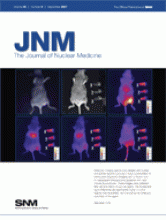Abstract
The aim of chemotherapy for mesothelioma is to palliate symptoms and improve survival. Measuring response using CT is challenging because of the circumferential tumor growth pattern. This study aims to evaluate the role of serial 18F-FDG PET in the assessment of response to chemotherapy in patients with mesothelioma. Methods: Patients were prospectively recruited and underwent both 18F-FDG PET and conventional radiological response assessment before and after 1 cycle of chemotherapy. Quantitative volume-based 18F-FDG PET analysis was performed to obtain the total glycolytic volume (TGV) of the tumor. Survival outcomes were measured. Results: Twenty-three patients were suitable for both radiological and 18F-FDG PET analysis, of whom 20 had CT measurable disease. After 1 cycle of chemotherapy, 7 patients attained a partial response and 13 had stable disease on CT assessment by modified RECIST (Response Evaluation Criteria in Solid Tumors) criteria. In the 7 patients with radiological partial response, the median TGV on quantitative PET analysis fell to 30% of baseline (range, 11%–71%). After 1 cycle of chemotherapy, Cox regression analysis demonstrated a statistically significant relationship between a fall in TGV and improved patient survival (P = 0.015). Neither a reduction in the maximum standardized uptake value (P = 0.097) nor CT (P = 0.131) demonstrated a statistically significant association with patient survival. Conclusion: Semiquantitative 18F-FDG PET using the volume-based parameter of TGV is feasible in mesothelioma and may predict response to chemotherapy and patient survival after 1 cycle of treatment. Therefore, metabolic imaging has the potential to improve the care of patients receiving chemotherapy for mesothelioma by the early identification of responding patients. This technology may also be useful in the assessment of new systemic treatments for mesothelioma.
Footnotes
-
COPYRIGHT © 2007 by the Society of Nuclear Medicine, Inc.







